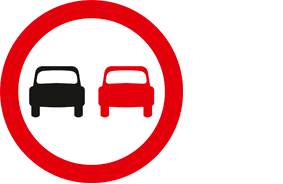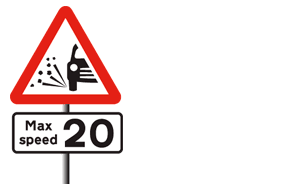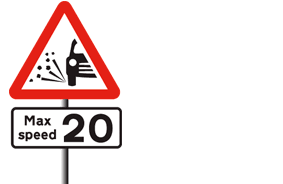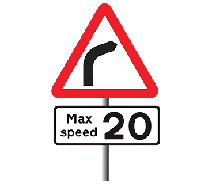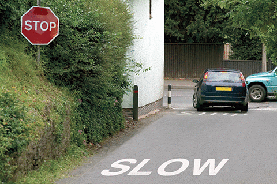
ADI Theory Mock Test
The duration of this ADI theory test is 90 minutes (1 hour 30 minutes). There are 100 multiple choice questions. You need at least 85/100 to pass. Click the Begin Test button when you're ready to start. You may review your answer after each question or wait until the end to view your overall result. Good luck!
Click on an answer to view the correct choice along with the explanation.
Explanation: As you approach a left turn, maintain your normal driving position on the left. Don't swing out before you turn, and make sure that you've reduced your speed and are in the correct gear. Look into the road before you turn and give way to any pedestrians who are crossing.
B
C
D
Explanation: Large, long and heavy vehicles will need more time to pass you than a car, especially uphill. If necessary, be prepared to slow down to let them pass.
Explanation: You mustn't stop on the hard shoulder, except in an emergency. Never use it to have a rest or a picnic, to pick up hitchhikers, to answer a mobile phone or to check a road map. You mustn't drive back along the hard shoulder if you go past the exit you wanted.
B
C
D
Explanation: Anyone who accompanies a learner driver on a driving test must be at least 16 years old and must wear a seat belt. (This includes a person who holds a seat-belt exemption certificate.) The accompanying driver mustn't take any part in the test. The examiner can end the test if they feel any inappropriate communication has taken place.
B
C
D
Explanation: Windscreen pillars can block your view, particularly at junctions. Those road users who are most at risk of not being seen are cyclists, motorcyclists and pedestrians. Never rely on just a quick glance.
Explanation: To park at night without lights, you must comply with certain conditions. The road must be subject to a 30 mph speed limit, or less. Parking too close to a junction or facing the flow of traffic could confuse and cause danger for other road users.
B
C
D
Explanation: The effects of shock may not be immediately obvious. Keep checking on casualties and talk to them to reassure them. Signs to look for include
- rapid pulse
- pale grey skin
- sweating
rapid, shallow breathing.
B
C
D
Explanation: At a road traffic incident, there's a real danger of further collisions and fire, so only approach if it's safe. Get someone to call the emergency services and, if there's an injured casualty, first check if they're breathing. If they're not breathing, you may need to give chest compressions until the ambulance arrives.
B
C
D
Explanation: At the scene of a crash, your first priority is to warn approaching traffic of the obstruction ahead. You can do this by displaying an advance warning triangle (but not on a motorway), switching on hazard warning lights or any other means that doesn't put you or anyone else at risk.
Explanation: If a horse is frightened, it may bolt or shy unpredictably, and the rider may lose control. To reduce the risk of frightening the horse, you should not make any unnecessary noise. Pass it slowly and give it plenty of room.
Explanation: This sign means it's illegal to overtake. It may have a black-and-white plate telling you over what distance the prohibition applies. There will normally be a sign with an 'End' plate where the prohibition ends.
Explanation: Stone chippings are often used to finish off a new road surface. They may take several days to bed into the tar underneath. Advisory speed limits are used to help reduce the amount of chippings thrown up by passing vehicles. Chippings can cause damage to vehicles and other road users - especially cyclists, pedestrians and horse riders. There's also an increased risk of skidding on the loose surface.
Explanation: The sign warning of loose chippings is often accompanied by a plate showing an advisory maximum speed. Stone chippings thrown up by tyres can damage vehicles, and pedestrians, cyclists and motorcyclists are more vulnerable. The loose surface will increase your vehicle's stopping distance and there's an additional risk of skidding.
Explanation: Many modern cars have cruise control fitted; it automatically maintains a steady speed set by the driver. Setting the cruise control when you can see the road well ahead is clear can help keep fuel consumption down and reduce vehicle emissions.
B
C
D
Explanation: If a casualty is bleeding heavily from a limb, raise it to a higher position - so long as it isn't broken. This will help to reduce the blood flow and so reduce the bleeding.
B
C
D
Explanation: The closer a driver gets to the vehicle in front, the less they can see of the road ahead. The safety aspects of keeping well back to gain a better view need to be emphasised and practised. It takes a long time to overtake a long vehicle and a good view of the road ahead is necessary to see that there's enough room to overtake safely.
Explanation: Too much oil in the engine will create excess pressure and could damage the engine seals and cause oil leaks. Any excess oil should be drained off.
B
C
D
Explanation: When your vehicle is too big to fit into the central reservation, you should treat a dual carriageway as one road and wait until the road is clear in both directions before emerging to turn right. If you try to treat it as two separate roads and wait in the middle, your vehicle will overhang the central reservation and could cause a collision.
B
C
D
Explanation: Normally, you should place your warning triangle on the same side of the road as your vehicle, and at least 45 metres (147 feet) behind it. On a very narrow road, the triangle itself could be a hazard and is best placed off the road but in a clearly visible position. Don't place a warning triangle on a motorway.
Explanation: Questions that require a simple 'yes' or 'no' are of limited value. To be effective, you should ask searching questions based on 'what', 'when', 'where', 'why' and 'how'. The power of effective questioning as an aid to learning is sometimes overlooked; it can help to motivate pupils.
B
C
D
Explanation: When leaving your car, take all valuables with you, if you can. Otherwise, lock them out of sight.
B
C
D
Explanation: Turning the wheels to the left will ensure that if the vehicle rolls forward, it will immediately contact the kerb. The use of reverse gear will help by using the resistance of the engine to prevent the vehicle from rolling forwards should the parking brake fail.
B
C
D
Explanation: By keeping well back from the large vehicle, you'll increase your view past it. This will allow you to see further down the road and be prepared for any hazards.
B
C
D
Explanation: If your vehicle breaks down, use hazard warning lights as well as a warning triangle or other device to warn other drivers. It's even more important to do this in the dark. Warning triangles should be placed at least 45 metres (147 feet) from your vehicle and on the same side of the road. Don't use a warning triangle on a motorway.
B
C
D
Explanation: You must stop if you've been involved in a collision that results in any injury or damage. You must also be able to produce your driving licence when a police officer asks to see it. If you can't do this at the time, you may be asked to take it to a police station within a certain period. You may also be asked to show a valid insurance certificate and a valid MOT certificate.
Explanation: A primary route is a road of national or regional importance and is the major route between larger towns and cities. The direction signs on these routes have green backgrounds. Many maps and road atlases show these routes in green.
Explanation: The 'max speed' plate advises the maximum safe speed for negotiating the hazard shown on the warning sign. Drivers should slow down, as the hazard can be deceiving; for example, a bend may be much sharper than it initially appears.
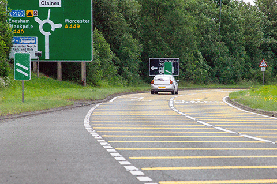
B
C
D
Explanation: Yellow lines are painted across the road on the approach to some roundabouts. The lines are usually found on dual carriageways, where traffic speeds are higher, or at the end of motorway exit slip roads. They provide a visual warning to remind drivers to check their speed.
B
C
D
Explanation: In winter, check the local weather forecast for warnings of icy or snowy weather. Don't drive in these conditions unless your journey is essential. If it is essential, take great care. Carry a spade, warm clothing, a warm drink and emergency food, in case your vehicle breaks down or becomes stuck in snow or traffic.
B
C
D
Explanation: When parking, all ancillary controls should be switched off and the engine stopped. Make sure that the handbrake is applied firmly before leaving the vehicle.
Explanation: The safest rule is never to drink and drive. Alcohol seriously affects judgement and concentration. It will reduce driving ability, give a false sense of confidence and slow down reactions.
B
C
D
Explanation: Watch out for emerging vehicles, as the driver's view may be obscured at some junctions. If a vehicle pulls out and you're not sure whether the driver has seen you, slow down and be prepared to stop. Be tolerant and don't sound the horn in anger.
Explanation: Selecting a low gear will help the engine's resistance, known as engine braking, to control your vehicle's speed. This is especially useful when travelling downhill.
B
C
D
Explanation: If you drive at speed in very wet conditions, your steering may suddenly feel lighter than usual. This means that the tyres have lifted off the surface of the road and are skating on the surface of the water. This is known as aquaplaning. Reduce speed by easing off the accelerator, but don't brake until your steering feels normal again.
Explanation: Snow chains can be fitted to your tyres when snow affects the driving conditions. They can help you to move off from rest or to keep moving in deep snow. You'll also need to adjust your driving to deal with these conditions; don't rely on technology such as anti-lock brakes to overcome bad driving choices.
Explanation: When there's reduced grip (for example, when there's wet mud, snow or ice on the road), drive in a high gear. The engine then drives the wheels with less torque than if you were using a low gear, and this reduces the likelihood of wheelspin.
Explanation: Fog lights will help others see you, but they must only be used if visibility is seriously reduced. You must turn fog lights off when visibility improves, to avoid dazzling other road users.
Explanation: If the road surface is loose, it's possible for the loose surfaces to slide over each other. A vehicle's tyres may grip the surface layer but this may slide across a lower layer. An anti-lock braking system would be less effective in this situation.
Explanation: Driving a vehicle without insurance cover is illegal. If you cause injury to anyone or damage their property, it could be very expensive and you could also be subject to criminal prosecution.
B
C
D
Explanation: If you can't see all around your vehicle, get out and have a look. You could also ask someone reliable outside the vehicle to guide you. A small child could easily be hidden directly behind you.
Explanation: Motorways mustn't be used by
- pedestrians
- motorcyclists who hold provisional entitlement for the motorcycle they're riding
- riders of motorcycles under 50 cc
- cyclists
- horse riders
- agricultural vehicles
- powered wheelchairs/powered mobility scooters
- certain slow-moving vehicles and those carrying oversize loads (except by special permission).
B
C
D
Explanation: It's especially dangerous to park on the road in fog. If it's unavoidable, then leave your parking lights switched on.
B
C
D
Explanation: The flashing amber light allows pedestrians who are already on the crossing to get to the other side before the green light shows to traffic. Give way to them and only proceed when the crossing is clear.
B
C
D
Explanation: Only drive if you're fit to do so. Some medication can affect your concentration, your ability to stay awake and your judgement when dealing with hazards. Driving while taking such medication is highly dangerous.
B
C
D
Explanation: If you have to drive in fog during daylight, use dipped headlights. If visibility is below 100 metres (328 feet), use high-intensity fog lights; they help other road users to see you.
B
C
D
Explanation: Don't travel unless you really have to. Making unnecessary journeys will increase the risk of being involved in an incident. If you do decide to use your car, it's important that you can see and be seen. Make sure any snow or ice is cleared from lights, mirrors, number plates and windows.
Explanation: In good, dry conditions, an alert driver who's driving a vehicle with tyres and brakes in good condition needs to keep a gap of at least two seconds from the car in front. When the road surface is wet, the gap needs to be increased to four seconds - and if it's icy, then the gap needs to increase to as much as 20 seconds.
B
C
D
Explanation: An interested pupil is likely to be well motivated and should retain information better than one who has lost interest. Everyone has different abilities, so instruction needs to be varied to suit the individual.
B
C
D
Explanation: Vehicles that require an MOT certificate mustn't be driven on the road after the certificate has expired. Exceptionally, the vehicle may be driven to and from a pre-arranged MOT test appointment or to a garage for repairs required for the test.
B
C
D
Explanation: A person who's colour-blind will have to take exactly the same practical driving test as any other candidate. No restriction will be placed on their driving licence when they pass their test.
Explanation: Most pedestrian crossings are for pedestrians only, but the toucan crossing has been designed to be shared by both pedestrians and cyclists. You can expect to find a toucan crossing where a cycle route and a footpath cross a road at the same point.
B
C
D
Explanation: If you brake while travelling in a straight line, the inertia of the vehicle tries to keep it moving forward. This moves the weight of the vehicle forward and onto the front wheels. This extra load on the front tyres will press them more firmly into contact with the road, giving more tyre grip.
B
C
D
Explanation: It's important to be seen as well as be able to see. In conditions of reduced daytime visibility, you should switch on your dipped headlights. This increases your visibility without the risk of dazzling approaching drivers.
B
C
D
Explanation: The right-hand lane of the motorway is for overtaking. Once overtaking is completed, you should return to the lane on your left. Sometimes you may be directed into a right-hand lane as a result of roadworks or an incident. This will be indicated by signs or officers directing the traffic.
Explanation: High-intensity rear fog lights are far brighter than normal rear lights. When visibility is reduced to 100 metres (328 feet) or less, they should be used to help drivers behind to see your vehicle. When visibility improves, these high-intensity lights should be switched off to avoid dazzling drivers behind.
B
C
D
Explanation: If another driver wishes to travel faster than you, it isn't your role to try and stop them. Move to the left when it's safe and let them pass, even if they appear to be breaking the speed limit.
B
C
D
Explanation: Properly timed signals tell other road users what you intend to do. When you're turning right at a roundabout, signal left just after passing the exit before the one you wish to take. This helps drivers behind and also those waiting to join the roundabout.
B
C
D
Explanation: Any medical condition that would affect your driving must be reported to the DVLA Drivers Medical Group or, in Northern Ireland, the DVA Drivers Medical Section. If you have any condition or you have to take any medication that you think might affect your driving, it's worth checking the information available on www.gov.uk
B
C
D
Explanation: An instructor must normally wear a seat belt during all practical training when there's one fitted to the vehicle, unless they're exempt. However, when a pupil is carrying out a manoeuvre that involves reversing, instructors may release the belt during the exercise; this gives them a little more freedom to teach the exercise safely.
Explanation: For the purposes of driving a motor car, deafness isn't classed as a disability. Having passed their test, deaf drivers won't have their licence restricted.
B
C
D
Explanation: A driver who has difficulty in turning their head will require suitably positioned additional mirrors. These will help overcome their limited zone of vision. Training and guidance will be needed in the correct and timely use of these additional mirrors.
B
C
D
Explanation: When you park a vehicle facing uphill and on the left, turn the steering wheel to the right. If the parking brake fails, this will give the front wheels the least distance to travel before wedging against the kerb, preventing the vehicle from rolling further. It's also a good idea to leave the car in gear, or select 'P' on an automatic.
B
C
D
Explanation: Use the hard shoulder like an acceleration lane. Build up your speed and wait for a suitable gap before merging into the left-hand lane of the motorway.
B
C
D
Explanation: Driving instructors who always display L plates on a training vehicle are exempt from having to remove them when a full licence holder is driving the car.
B
C
D
Explanation: Photocard licences are valid for a maximum of 10 years. This is to allow the photographic likeness to be updated when the licence is renewed. However, the licence entitlement usually lasts until age 70.
B
C
D
Explanation: A 16 year old may drive a car if they're in receipt of the enhanced rate of the mobility component of Personal Independence Payment. However, if the enhanced rate is withdrawn, the normal minimum age for driving a car (17 years old) will then apply.
Explanation: The flashing amber light comes on after the red light, and people may still be crossing. If the crossing is clear and it's safe, you may drive on without waiting for the green light.
Explanation: Long white lines with short gaps mean there's a hazard ahead. Often a warning sign will show you the nature of the hazard. Don't cross the line unless you can see the road is clear well ahead and you wish to overtake or turn off.
B
C
D
Explanation: When turning right from a side road across a dual carriageway, make sure that the central reservation is wide enough to contain your vehicle. If it isn't, you'll have to treat the dual carriageway as one road and only emerge when it's clear in both directions. Drivers of longer vehicles and vehicles towing trailers or caravans will need to assess this carefully. If any part of an emerging vehicle obstructs the right-hand lane of the dual carriageway, it could have serious consequences.
B
C
D
Explanation: If your usual techniques or methods don't appear to be working, you should discuss the matter with your pupil, and explore alternative ways of getting the point across.
B
C
D
Explanation: The extended test takes about 70 minutes and is assessed to the same level as the standard driving test for learner drivers.
B
C
D
Explanation: If you're waiting at a junction and a vehicle is approaching from your right, signalling to turn left into your road, wait until you're sure it's turning before emerging. It may be that the driver intends to stop on the left beyond your road, or they may have forgotten to cancel the signal from a previous manoeuvre.
Explanation: It's more difficult to judge speed and distance in conditions of poor visibility, when shapes or outlines can become less distinct and potentially more confusing. You must always be able to stop in the distance that you can see to be clear.
Explanation: All motor vehicles are fitted with a horn; its purpose is to warn other road users of the vehicle's presence. You mustn't sound the horn between 11.30 pm and 7.00 am in a built-up area or when you're stationary, except when another road user poses a danger.
Explanation: Sooner or later, another driver will do something that affects you. This can result in a range of feelings such as anger or fear, and you may struggle to concentrate on your driving. If you find yourself in this situation, it's best to look for a safe place to stop and give yourself time to recover. Any form of retaliation will lead to increased risk.
Explanation: To prevent your headlights from dazzling the driver of the car in front, wait until you've overtaken before switching to full beam.
B
C
D
Explanation: Before you turn into a junction, make sure the way is clear. Pedestrians who have started crossing have priority and you must let them cross in their own time.
B
C
D
Explanation: Take care to understand what the approaching driver intends, as this may determine your approach. Turning behind the approaching vehicle, wherever possible, will ensure that your view of the road ahead isn't blocked. At some junctions, the layout may make it difficult to turn this way; if this is the case, be prepared to pass in front of the other vehicle. At some junctions, the lane markings direct you to turn this way.
Explanation: Serious incidents have occurred when vehicles or people on the hard shoulder have been struck by vehicles using the left-hand lane of the motorway. While using the emergency telephone, be alert and watch for approaching traffic.
B
C
D
Explanation: At a roundabout, a horse rider wanting to turn right may feel safer keeping to the left all the way around the roundabout. Stay well back. Driving close behind or alongside could frighten the horse.
B
C
D
Explanation: Try to plan your journey so that you can take rest stops. It's recommended that you take a break of at least 15 minutes after every two hours of driving. This should help to maintain your concentration.
B
C
D
Explanation: Where street repairs have closed off pavements, proceed carefully and slowly, as pedestrians might have to walk in the road.
B
C
D
Explanation: A toucan crossing is designed to allow pedestrians and cyclists to cross at the same time. Look out for cyclists approaching the crossing at speed.
Explanation: On a single carriageway road, the national speed limit will apply, unless signs indicate otherwise. For a car, the limit is 60 mph unless the car is towing a trailer - in which case the limit is reduced to 50 mph.
Explanation: A long vehicle may have to straddle lanes on, or approaching, a roundabout. This is to prevent the rear wheels from going up onto the kerb. If you're following a long vehicle, stay well back and give it plenty of room.
Explanation: You should normally use the left-hand lane on any dual carriageway, unless you're overtaking or turning right. When overtaking on a dual carriageway, look for vehicles ahead that are turning right. They're likely to be slowing or stopped. You need to see them in good time so that you can take appropriate action.
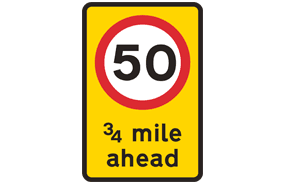
B
C
D
Explanation: Where there are extra hazards such as roadworks, it's often necessary to slow traffic down by imposing a temporary speed limit. The speed-limit sign will be circular and edged with a red ring. This tells you that the sign is an order and you must obey it.
B
C
D
Explanation: Red rear reflectors show up when headlights shine on them. These are useful when you're parked at night but will only reflect if you park in the same direction as the traffic flow. Normally you should park on the left, but if you're in a one-way street you may also park on the right-hand side.
Explanation: You should keep to the left and only use the centre or right-hand lanes if you're passing slower-moving traffic.
Explanation: You normally join a motorway from a slip road on the left. Join where there's a suitable gap in the traffic travelling in the left-hand lane. You should adjust your speed to fit in with the traffic flow in the left-hand lane, but you must give way to the traffic already on the motorway. Don't try to force your way into the traffic stream.
B
C
D
Explanation: If you intend to overtake on a two-way road that has three lanes, you must consider that approaching traffic could be planning the same manoeuvre. When you've considered the situation and have decided it's safe, indicate your intentions early. This will show the approaching traffic that you intend to pull out. Some of these roads have solid white lines marked to allow for overtaking in one direction only, usually for uphill traffic.
B
C
D
Explanation: If you see a motorcyclist take a quick glance over their shoulder, this could mean they're about to change direction. Recognising a clue like this helps you to be prepared and take appropriate action, making you safer on the road.
B
C
D
Explanation: When a vehicle is travelling slowly, the driver or rider is probably looking for a turning or entrance. Be patient and stay behind them. They're quite likely to change direction or stop, suddenly and without signalling.
B
C
D
Explanation: Be aware that elderly people might take a long time to cross the road. They might also be hard of hearing and not hear you approaching. Don't hurry elderly people across the road by getting too close to them or revving your engine.
Explanation: As people age, their reactions tend to slow and they can take longer to assess hazards. Don't try to rush them, but be tolerant and patient.
Explanation: At blind junctions, there's often a 'stop' sign. The 'stop' sign has been put there because the view into the main road is poor. You must stop because it won't be possible to assess the situation on the move, however slowly you're travelling.
Explanation: A black-and-white chevron sign gives an advance warning to drivers that the road ahead bends sharply in the direction indicated by the chevron. This advance information allows drivers to adjust their speed in good time and select the correct gear for their speed.
B
C
D
Explanation: Signals should be cancelled soon after use. If a driver is unsure of the location of a junction or destination, they may signal earlier than normal while looking for their turn. Don't attempt to overtake, as they may turn suddenly.
B
C
D
Explanation: If you wish to overtake a long vehicle, stay well back so that you can see the road ahead. Don't
-get too close to the vehicle, as this will restrict your view of the road ahead
-get impatient; overtaking on a busy road calls for sound judgement
-take a gamble; only overtake when you can see that you can safely complete the manoeuvre.
B
C
D
Explanation: All vehicles must display parking lights when parked on a road with a speed limit greater than 30 mph. Park in the direction of the traffic flow so that your parked vehicle isn't mistaken for a moving vehicle.
ADI Theory Test Practice
About the ADI Theory Test
Contents
The complete ADI test is made up of the theory test (part 1: £81), a practical test (part 2: £111), and an instructional ability test (part 3: £111). You will also need to meet certain requirements to become an instructor, get a trainer, get practice teaching (optional), and register as an instructor. The ADI theory test itself is made up of 2 key component parts as laid out below:
Multiple Choice
This is made up of 100 multiple choice questions broken down into 4 categories. You will have 90 minutes to answer as many of these as you can. To pass, you will need to answer at least 85/100 correctly. You also need to answer at least 20/25 questions correctly across each of the 4 categories.
Hazard Perception
This includes 14 CGI video examples of potential real-life scenarios that could affect you at work. In each clip, there will be at least 1 developing hazard. However, one clip will contain 2 developing hazards. For each of the developing hazards, you can score up to 5 points. You will receive a higher score for spotting a developing hazard quicker. The pass mark for the hazard perception test is 57 out of a possible 75.
What is included in the ADI multiple-choice test?
On the day of the test, you will be given instructions on how it works. You will also be given some time to get used to answering questions on the test centre computers. As outlined, the multiple-choice test includes 100 questions across 4 categories. To pass you need an overall pass mark of 85% (85/100) and 80% for each category (20/25).
The 4 categories you will be asked questions on are:
Road procedure
For example, this might include questions about stopping distances in wet weather and driving in poor conditions, safety considerations when reversing, and motorway safety.
Traffic signs and signals, car control, mechanical knowledge, and pedestrian responses
For example, this will test sign comprehension, consideration for other road users, and safe vehicle use.
Driving test, disabilities, and legal regulations
For example, this could include questions regarding insurance, understanding reasonable adjustments for people with a disability, and regulations surrounding the vehicle such as parking and seat belts.
Publications and techniques for instruction
For example, this will include questions on how to approach errors of pupils, how to provide reasonable adjustments, and how to teach good practice.
For the multiple-choice section of the ADI theory test, it is possible to return to questions. If you are unsure of an answer, simply flag the question and you can return to it later if you still have time. You have 90 minutes to complete the test. However, if you finish early, then you do not have to use all of this time. You are also allowed to take a 3-minute break before starting the hazard perception test.
ADI hazard perception test
Prior to starting the hazard perception test, you will be shown an instructional video. This will take you through the scoring and how to spot a developing hazard. Simply put, a developing hazard is anything you see that might cause you to take an action. This might be changing your speed or altering your direction of travel. For example, this might be a parked car at the side of the road turning its indicator on.
You can score up to 5 points per hazard. 5 points will be awarded if you spot a developing hazard straight away. 0 points will be awarded if you do not spot a developing hazard during a clip. As such, you should click as soon as you see something that could be a developing hazard. You will not be docked points for clicking if you were wrong. However, if you click in any sort of pattern or continuously, you will be given a score of zero.
Unlike the multiple-choice part of the ADI theory test, you cannot review your answers. This means you get one time only per video clip (although you can click more than once per video clip). Remember that there is always at least one developing hazard in each of the 14 clips you are shown. One clip also contains 2 developing hazards, so you should always stay alert for hazards, as you would on the road.
ADI theory test pass mark
To pass the ADI theory test you need to achieve a pass mark for both the multiple-choice and hazard perception components. You need to score 85 out of 100 on the multiple-choice test. This must include getting at least 20 out of 25 for each of the 4 categories being tested. As such, it is possible to score over 85 and still fail the test. You need 57 out of 75 to pass the hazard perception test.
If you pass both parts of the ADI theory test, you will be given a pass certificate on the day of your test. The certificate is valid for 2 years and is required in order to take the Approved Driving Instructor part 2 test, a practical test.
If you fail either part of the ADI theory test, you will be given a breakdown of your scores. This will show the parts of the test you didn’t score enough on. This can help you when practising for the next test. You cannot book a re-sit until at least 3 working days after sitting your last test.
ADI theory booking
You need to apply to start the ADI qualification process and have this accepted before you can book a test. You will also need to obtain a Disclosure and Barring Service (DBS) check to begin your application. You are eligible to apply if:
- You are 21 or over
- You have held a full driving licence for a minimum of 3 years
- You have not been disqualified from driving in the last 4 years
Your application may also be refused if:
- You have ever been banned from driving
- You have 5 penalty points or more
- You have been convicted of non-motoring offences
- You have been banned from working with children
If you only have an automatic licence, you are only able to teach people how to drive an automatic car. However, if you have an automatic licence because of a disability, you can take an additional test to allow you to teach drivers of manual cars. You will need to prove you can keep control of the car in an emergency.
ADI Theory Test practice
You will need to practice your knowledge of the following areas:
- The highway code
- Traffic signs
- Essential driving skills
- The driving instructor’s handbook
- Hazard perception
How to prepare
You are expected to have a higher standard of knowledge for the ADI theory test than the standard learner theory test. Fortunately, this will help you teach your students. The process of learning for your theory test will also be beneficial for you when it comes to preparing your students. Try to keep track of what you find useful when studying for the test and pass this information on. Be sure to practice questions covering each of the 4 categories that will be covered by the multiple-choice test.
It is also important to practice using example hazard perception videos. Remember, these will also require a higher level of knowledge than the standard learner hazard perception test. As you need to pass both sections to move on to the next stage, you should be sure to make time to practice hazard perception. As you only get one chance during the test, make sure to pass a few practice tests before booking your test.
Next Steps
Step 1
- Check you meet eligibility requirements to apply.
Step 2
- Apply to become an approved driving instructor.
- Get a DBS check (£6)
Step 3
- Hire a trainer to prepare you for the 3 parts of the ADI (£ = instructor dependent).
Step 4
- Take the ADI Theory Test – ADI part 1 (£81)
- Complete ADI parts 2 and 3 within 2 years of passing ADI part 1
Step 5
- Prepare for the driving ability test – ADI part 2
- Book the ADI part 2 test (£111)
- If you fail this test twice, you may be required to retake Part 1
Step 6
- It is advised that you apply for a trainee driving instructor licence after passing ADI part 2. This is an optional stage to help you prepare for part 3. However, you can book ADI part 3 once passing Part 2. (£140)
- Get experience teaching students for up to 6 months.
Step 7
- Prepare for the instructional ability test – ADI part 3
- Book your test (£111)
Step 8
- Register for an ADI certificate (£300)
- Begin work as an instructor
Step 9
- Renew your licence every 4 years
- Renew DBS every 4 years
- Submit to a standards check at least once every 4 years



